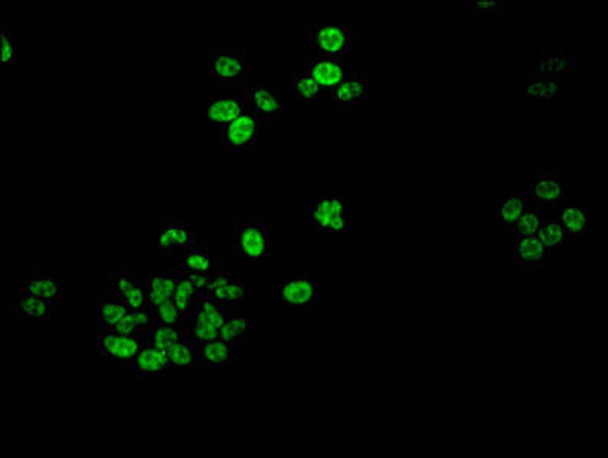Description
Phospho-HIST1H1B (S188) Antibody (PACO56608)
The Phospho-HIST1H1B (S188) Antibody (PAC05608) is a specialized research tool designed for studies involving the phosphorylation of the histone protein HIST1H1B at serine 188. This antibody, produced in rabbits, exhibits high reactivity with human samples and has been rigorously validated for use in Western blot applications. By specifically binding to the phosphorylated form of HIST1H1B, researchers can accurately detect and analyze this important histone modification in various cell types.Histone phosphorylation, including that of HIST1H1B at serine 188, plays a crucial role in regulating gene expression, chromatin structure, and ultimately cellular function.
Understanding the impact of this histone modification is essential for unraveling complex biological processes such as transcriptional regulation, DNA repair, and cell differentiation. The Phospho-HIST1H1B (S188) Antibody is an invaluable tool for investigating the role of histone phosphorylation in diverse areas of research, including epigenetics, cancer biology, and developmental biology.
| Antibody Name: | Phospho-HIST1H1B (S188) Antibody (PACO56608) |
| Antibody SKU: | PACO56608 |
| Size: | 50ul |
| Host Species: | Rabbit |
| Tested Applications: | ELISA, WB, IF |
| Recommended Dilutions: | ELISA:1:2000-1:10000, WB:1:100-1:1000, IF:1:50-1:200 |
| Species Reactivity: | Human, Rat |
| Immunogen: | Peptide sequence around site of Phospho-Ser (188) derived from Human Histone H1.5 |
| Form: | Liquid |
| Storage Buffer: | Preservative: 0.03% Proclin 300 Constituents: 50% Glycerol, 0.01M PBS, pH 7.4 |
| Purification Method: | Antigen Affinity Purified |
| Clonality: | Polyclonal |
| Isotype: | IgG |
| Conjugate: | Non-conjugated |
 | Western Blot. Positive WB detected in: Rat kidney tissue. All lanes: HIST1H1B antibody at 1µg/ml. Secondary. Goat polyclonal to rabbit IgG at 1/50000 dilution. Predicted band size: 23 kDa. Observed band size: 32 kDa. |
 | Immunofluorescent analysis of HepG2 cells using PACO56608 at dilution of 1:100 and Alexa Fluor 488-congugated AffiniPure Goat Anti-Rabbit IgG(H+L). |
| Background: | Histone H1 protein binds to linker DNA between nucleosomes forming the macromolecular structure known as the chromatin fiber. Histones H1 are necessary for the condensation of nucleosome chains into higher-order structured fibers. Acts also as a regulator of individual gene transcription through chromatin remodeling, nucleosome spacing and DNA methylation (By similarity). |
| Synonyms: | Histone H1.5 (Histone H1a) (Histone H1b) (Histone H1s-3), HIST1H1B, H1F5 |
| UniProt Protein Function: | H1B: Histone H1 protein binds to linker DNA between nucleosomes forming the macromolecular structure known as the chromatin fiber. Histones H1 are necessary for the condensation of nucleosome chains into higher-order structured fibers. Acts also as a regulator of individual gene transcription through chromatin remodeling, nucleosome spacing and DNA methylation. Belongs to the histone H1/H5 family. |
| UniProt Protein Details: | Protein type:DNA-binding Chromosomal Location of Human Ortholog: 6p22.1 Cellular Component: nuclear chromatin; nuclear heterochromatin; nucleosome Molecular Function:chromatin DNA binding; histone deacetylase binding Biological Process: establishment and/or maintenance of chromatin architecture; negative regulation of transcription from RNA polymerase II promoter; nucleosome assembly; positive regulation of cell growth; positive regulation of histone H3-K9 methylation; protein stabilization |
| NCBI Summary: | Histones are basic nuclear proteins responsible for nucleosome structure of the chromosomal fiber in eukaryotes. Two molecules of each of the four core histones (H2A, H2B, H3, and H4) form an octamer, around which approximately 146 bp of DNA is wrapped in repeating units, called nucleosomes. The linker histone, H1, interacts with linker DNA between nucleosomes and functions in the compaction of chromatin into higher order structures. This gene is intronless and encodes a replication-dependent histone that is a member of the histone H1 family. Transcripts from this gene lack polyA tails but instead contain a palindromic termination element. This gene is found in the small histone gene cluster on chromosome 6p22-p21.3. [provided by RefSeq, Aug 2015] |
| UniProt Code: | P16401 |
| NCBI GenInfo Identifier: | 19856407 |
| NCBI Gene ID: | 3009 |
| NCBI Accession: | P16401.3 |
| UniProt Secondary Accession: | P16401,Q14529, Q3MJ42, |
| UniProt Related Accession: | P16401 |
| Molecular Weight: | 22,580 Da |
| NCBI Full Name: | Histone H1.5 |
| NCBI Synonym Full Names: | histone cluster 1, H1b |
| NCBI Official Symbol: | HIST1H1B |
| NCBI Official Synonym Symbols: | H1; H1B; H1.5; H1F5; H1s-3 |
| NCBI Protein Information: | histone H1.5 |
| UniProt Protein Name: | Histone H1.5 |
| UniProt Synonym Protein Names: | Histone H1a; Histone H1b; Histone H1s-3 |
| Protein Family: | Histone |
| UniProt Gene Name: | HIST1H1B |
| UniProt Entry Name: | H15_HUMAN |















